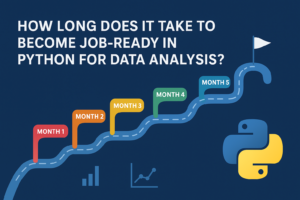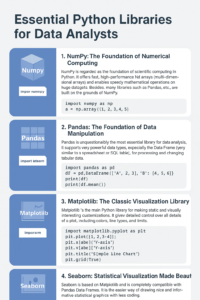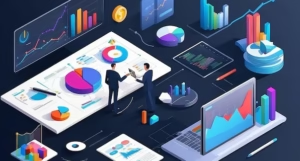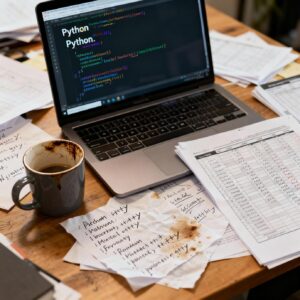Introduction: A New Era of Thinking in Data
In 2025, data analytics isn’t just reshaping industries — it’s reshaping how we think, act, and solve real-world problems. In this age, data flows like current in an electric grid, lighting up every corner of business, education, and innovation.
We, as a scholarly community, find ourselves not just surrounded by data, but immersed in it. Over 328 million terabytes of data are generated daily — a number that invites us not just to measure, but to make meaning. What we do with that data — how we analyze, interpret, and act on it — determines whether we thrive or trail behind.
Let’s explore the forces defining the future of analytics. Let’s think through the tools, trends, and skillsets that equip us to reason with data — not merely react to it.
1. Why Data Analytics Is the Compass of the Digital World
Data is like a river — constantly moving, rich with depth, but without direction until we channel it through the lens of analytics. Whether it’s the video you’re recommended, or how a class is scheduled — analytics is behind it.
But what is the real issue we must look into? Without context, data is just noise. Analytics turns that noise into notes — building symphonies of insight.
Predictive models help companies forecast user behavior. Prescriptive analytics lets educators reimagine learning paths. These tools don’t just automate decisions — they amplify human thinking. As we step into 2025, analytics is less a back-office function and more the engine room of strategic planning.
2. The Trends That Are Transforming Analytics
Let us look at the dual forces at play — automation and interpretation.
On one side, we see AI-powered systems generating real-time insights, replacing manual dashboards. On the other, we see tools becoming more human — with NLP interfaces that let us talk to our data.
Some trends look like mere upgrades. Others signal a shift in how we understand analytics:
| Trend | What It Means for Us |
|---|---|
| AI-Powered Analytics | Algorithms generate insights faster than human analysts ever could. |
| Real-Time Decision Making | We no longer wait. Data speaks — we act instantly. |
| Self-Service BI Tools | Platforms like Tableau and Power BI allow everyone to analyze. No code required. |
| Privacy-First Analytics | GDPR and DPDP require us to rethink consent, ownership, and ethics. |
| NLP in Dashboards | We ask: “What’s the dropout rate?” The dashboard answers back visually. |
We must reflect — are we building systems to serve us, or systems that think for us?
3. EdTech and the Real Impact of Analytics
How do we see analytics influencing sectors in reality?
Look at education: the once one-size-fits-all model now bends and adapts — like clay in the hands of insight.
Let’s walk through the table below. It illustrates the depth of impact analytics has on key sectors:
| Sector | Impact in 2025 (Est.) | Applications |
|---|---|---|
| Healthcare | 90% | Diagnostics, patient monitoring, treatment plans |
| Finance | 88% | Fraud detection, credit risk, investment modeling |
| EdTech | 85% | Adaptive learning, dropout alerts, smart tutoring |
| Retail | 78% | Inventory control, targeted campaigns |
| Manufacturing | 75% | Predictive maintenance, supply chain efficiency |
At Craze Neurons, we see this change in our classrooms. Consider these features reshaping education:
- Personalized Learning — Students receive content aligned with their pace and understanding.
- Smart Classrooms — Dashboards show us attendance, engagement, and outcomes in real-time.
- AI Tutors — Systems adapt lesson difficulty based on live student progress.
- Dropout Prediction Models — We intervene early. We don’t wait for failure to act.
This isn’t theory. This is the now. And it challenges us to look not just at what is happening — but at why it must.
4. The Tools Redefining Analytics Work in 2025
In the toolkit of a data analyst, each tool is a lens through which we perceive the world.
Let us look closely at the evolution of some tools shaping the field from 2019 to 2025:
| Tool | Function | Use Case |
|---|---|---|
| Advanced Excel | Cleaning, formulas, pivot tables | Dashboards, business reporting |
| Python | Automation, analysis, ML pipelines | End-to-end data workflows |
| SQL | Data querying and management | Extract insights from structured data |
| Power BI | BI dashboards, reports | Business reporting in real time |
| Tableau | Visual analytics | Visual storytelling for complex data sets |
Python now serves as the multi-tool of analytics. But Excel and SQL remain essential — foundational bricks that still carry weight. Business leaders are not just using these tools to report — they use them to reason, reflect, and reframe decisions.
5. Essential Skills That Will Define Data Analysts in 2025
What must we cultivate in ourselves?
To succeed, we must be able to think in data and speak in stories. Technical know-how is necessary — but incomplete. We need:
- Data Storytelling — Insights must connect emotionally and logically.
- Strong SQL Skills — It’s the language behind most structured data.
- Understanding of ML — Not building models, but knowing what they mean.
- ETL Process Mastery — Knowing how data flows, and where errors creep in.
- Domain Context — Finance, healthcare, EdTech — it matters what you’re analyzing.
These skills form not just a resume — but a lens through which we look at the world.
6. Starting a Career in Data Analytics: The Craze Neurons Way
At Craze Neurons, we invite learners not to memorize — but to experience analytics.
Step 1: Build a Strong Foundation
- Google Data Analytics Certificate
- Khan Academy – Statistics
- Kaggle: Start competing, start contributing
Step 2: Learn by Doing
- Create simple dashboards
- Try: Dropout Predictor, Path Recommender, Teacher Feedback Analyzer
Step 3: Join Live Training
- Instructor-led sessions
- Hands-on industry projects
- Internship opportunities
What makes us different?
| We Offer | You Gain |
|---|---|
| Expert-led courses | Learn from real practitioners |
| Live mentorship | Ask questions, get real-time feedback |
| Career support | Build your resume, ace interviews |
| Internship opportunities | Apply skills in actual projects |
Register at: www.crazeneurons.com
7. Conclusion: Data Isn’t Just the Future — It’s the Present
We don’t lack data. We lack people who know what to do with it.
Analytics is the art of reasoning in numbers. In 2025, those who can reason with data — not just crunch it — will lead. This is not just about careers. It’s about clarity, insight, and impact.
Let us not just learn analytics. Let us live it — think through it, build with it, and act on it.
At Craze Neurons, we believe in empowering minds that question, explore, and innovate. Join us — not just to upskill, but to uplift your ability to think in the age of data.
In the Race of Careers, Every Second Counts
Today, a resume gets just 6 seconds of attention.
That’s fast. But not final.
We help you craft a custom, ATS-friendly resume that speaks for you—clearly and confidently.
All for just ₹599. Built with you, not just for you.
🔗 www.crazeneurons.com
📲 WhatsApp Support
In the World of Data, Every Insight Matters
Data is more than numbers. It helps us look into problems and ask why.
Quantitative shows what is happening.
Qualitative helps us understand why it’s happening.
We need both—to see the whole picture.
Join our Data Analysis Training. Now at 50% off.
🔗 www.crazeneurons.com
📲 WhatsApp Us: https://wa.me/918368195998
❓ Frequently Asked Questions
Q1. What background is needed to join Craze Neurons’ program?
A: None at all. Our program starts from scratch, designed for beginners. Whether you’re from a tech or non-tech background, we grow together from the ground up.
Q2. Is the resume you provide generic?
A: Not at all. Every resume is built from scratch based on your real strengths, skills, and career goals. We focus on showcasing what makes you stand out.
Q3. Do I get real-world experience through this program?
A: Yes. All our projects are practical, rooted in real-world scenarios. Eligible learners also get internship opportunities to apply their learning in professional settings.
Q4. Can I see learner feedback before joining?
A: Absolutely. Visit our website at www.crazeneurons.com to explore testimonials, learner reviews, and success stories.
Q5. Why choose Craze Neurons for data analytics and tech upskilling?
A: At Craze Neurons, we go beyond theory. We focus on building careers with:
- Expert-led courses in Python, Data Science, AI, and more
- Hands-on projects, hackathons, and real-world case studies
- Personalized career support including resume building, interview training, and internship assistance
Whether you’re starting fresh or aiming to upskill, we provide the tools, guidance, and mentorship you need to succeed in the tech industry.
Q6. What is the future of data analytics in 2025?
A: The future lies in real-time, AI-powered, and privacy-driven analytics supported by self-service tools that are easy to use and widely adopted.
Q7. Which tools dominate data analytics in 2025?
A: Python, SQL, Tableau, Power BI, and Google BigQuery lead the industry. These tools help with everything from data cleaning to visualization and advanced analytics.
Q8. How is EdTech using data analytics?
A: EdTech platforms use analytics for personalized learning paths, early dropout detection, AI tutors, and real-time student performance tracking.
Q9. Is data analytics a good career choice in India?
A: Yes. It ranks among the top 5 in-demand skills for 2025 with high-paying opportunities across sectors like finance, healthcare, education, and retail.
Q10. What are the essential skills for succeeding in data analytics?
A: Key skills include:
- Strong SQL knowledge
- Data storytelling
- Understanding ML fundamentals
- Mastery of ETL processes
- Domain knowledge (finance, EdTech, healthcare, etc.)
Q11. How can beginners start learning data analytics?
A: Start with free foundational courses like:
- Google Data Analytics Certificate (Coursera)
- Khan Academy (Statistics & Probability)
- Compete on Kaggle and contribute to GitHub
Then, enroll in hands-on, project-based programs like Craze Neurons for real-world learning.
Q12. Do I need to know coding for data analytics?
A: Basic knowledge of Python or R is useful but not mandatory. Tools like Power BI and Tableau support no-code or low-code analysis, making them beginner-friendly.
Q13. What job roles can I pursue after learning data analytics?
A: Career paths include:
- Data Analyst
- Business Intelligence Analyst
- Data Engineer
- Machine Learning Analyst
You can also work in specialized sectors like EdTech, healthcare, retail, and fintech.
Q14. Can I switch to data analytics from a non-technical background?
A: Absolutely. Many of our learners come from commerce, humanities, or management. Start with Excel and SQL, then gradually move to Python and machine learning basics.
🔗 Stay Connected
🌐 Website: www.crazeneurons.com
📢 Telegram: https://t.me/cenjob
📸 Instagram: https://www.instagram.com/crazeneurons
💼 LinkedIn: https://www.linkedin.com/company/crazeneurons
▶️ YouTube:https://www.youtube.com/@CrazeNeurons
📲 WhatsApp: +91 83681 95998







One Response
Explore countless interesting and practical resources at our platform.
Covering expert articles to daily updates , there’s something matching your interests.
Keep updated with curated resources built to assist and entertain readers .
This site provides a user-friendly navigation to help you discover tools you need .
Become part of a growing community who benefit from our high-quality content daily .
Start exploring today and discover the full potential our site provides .
https://zhez.info